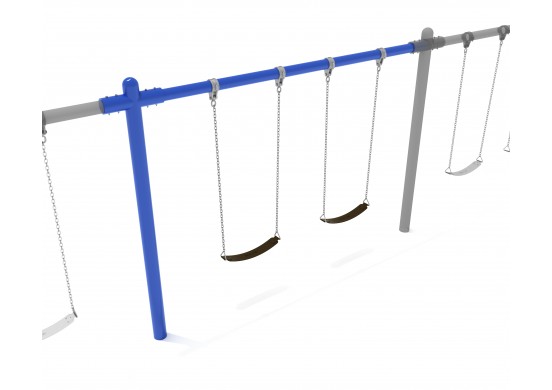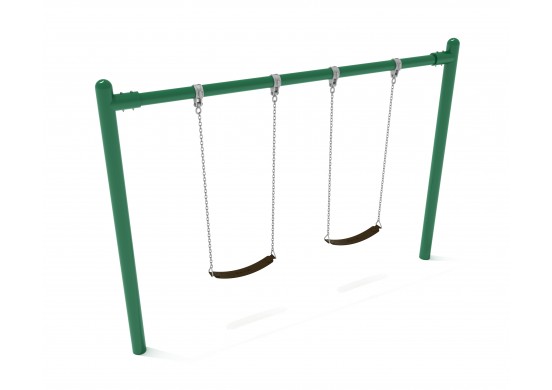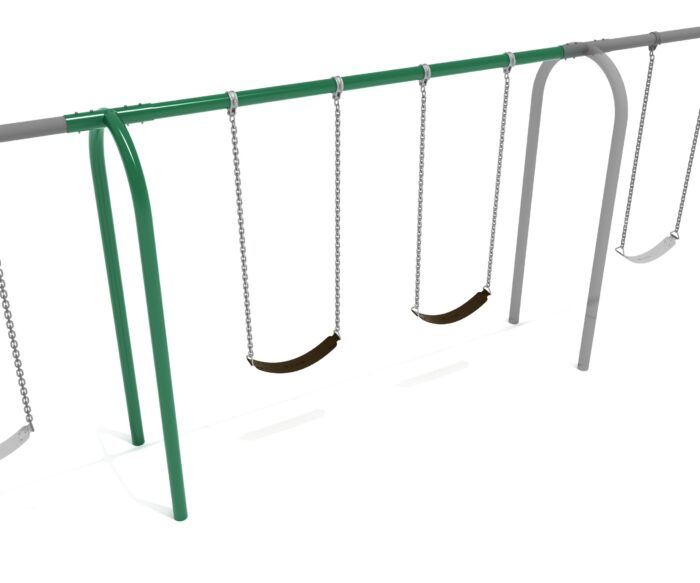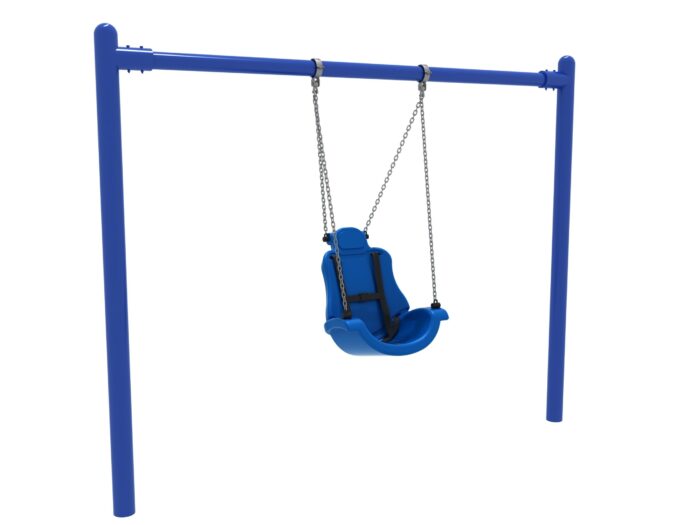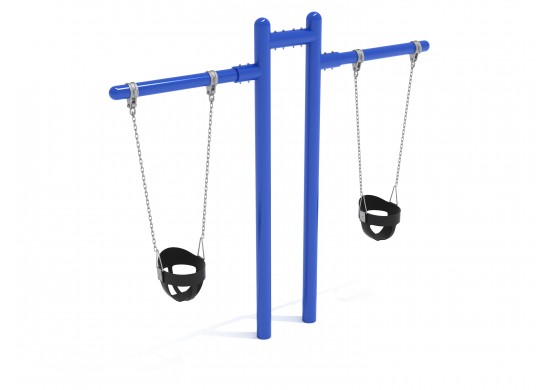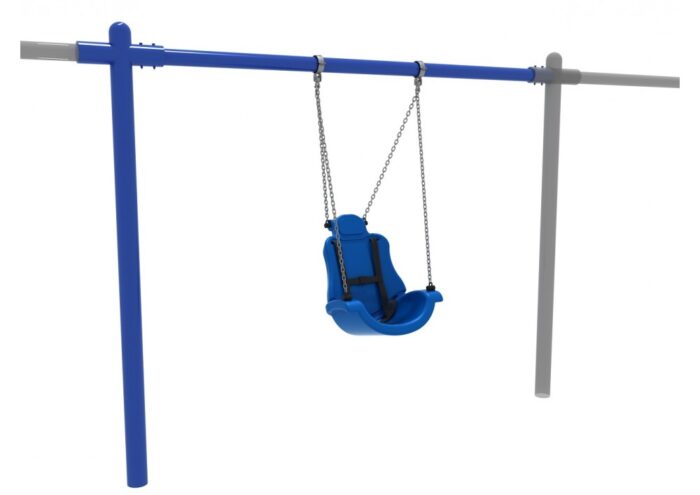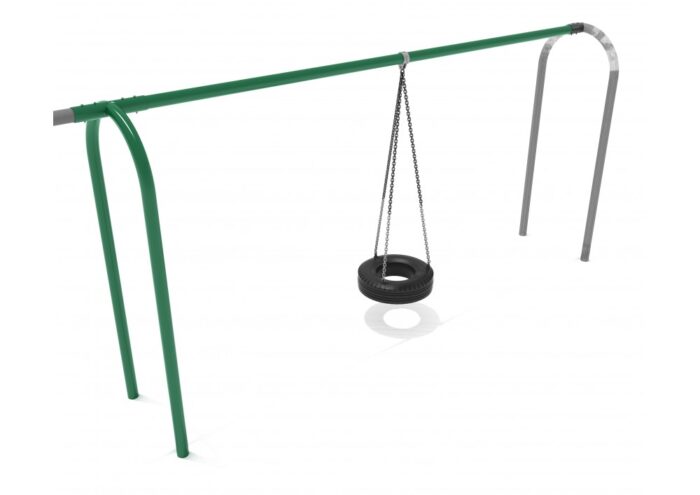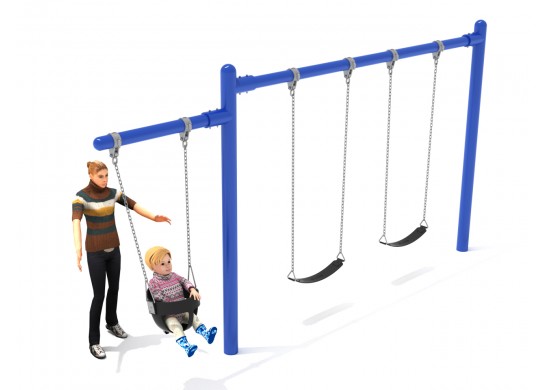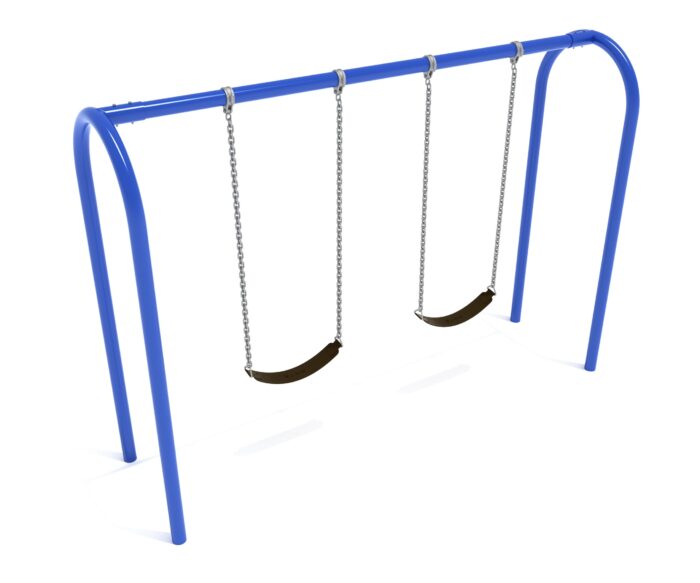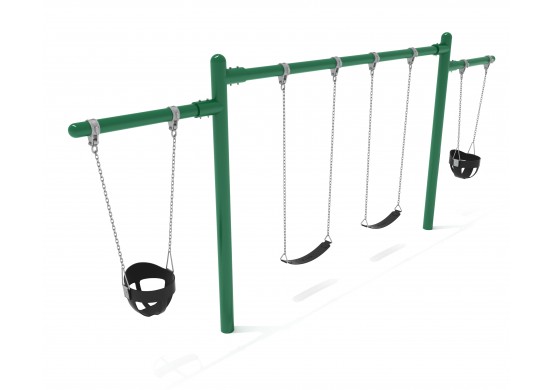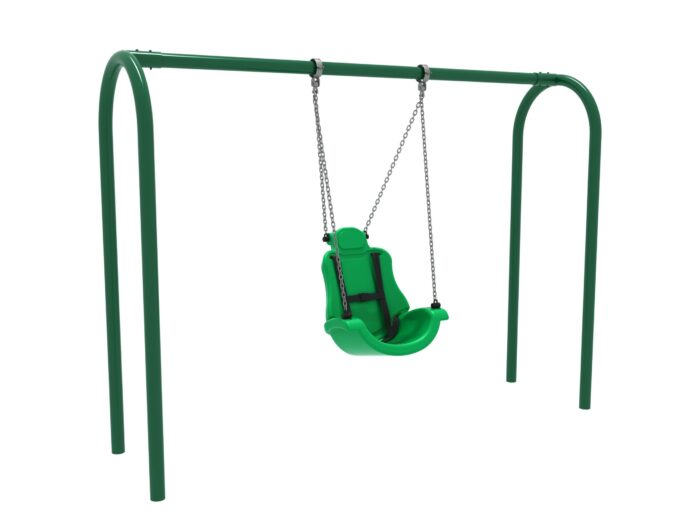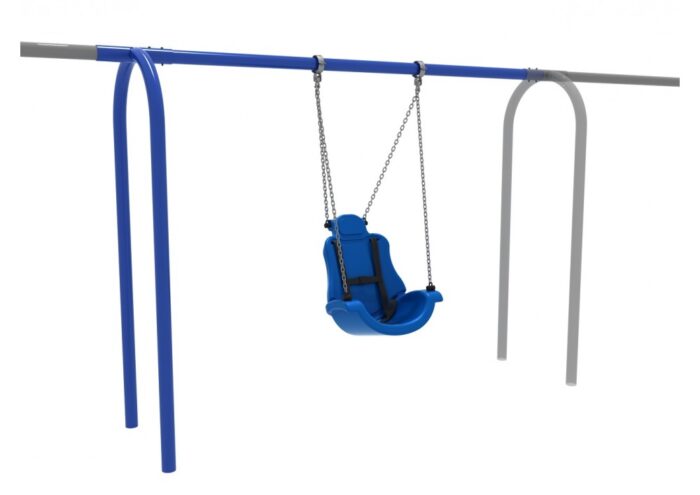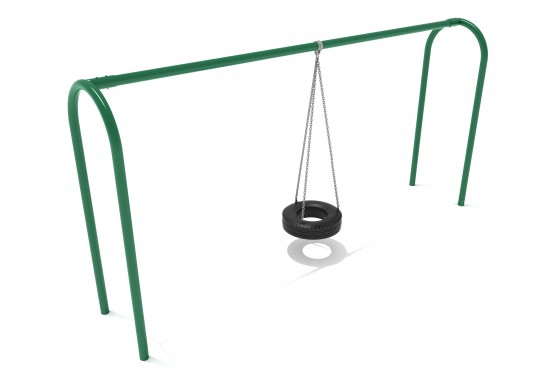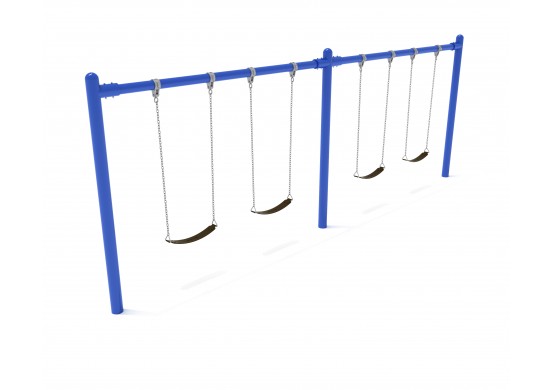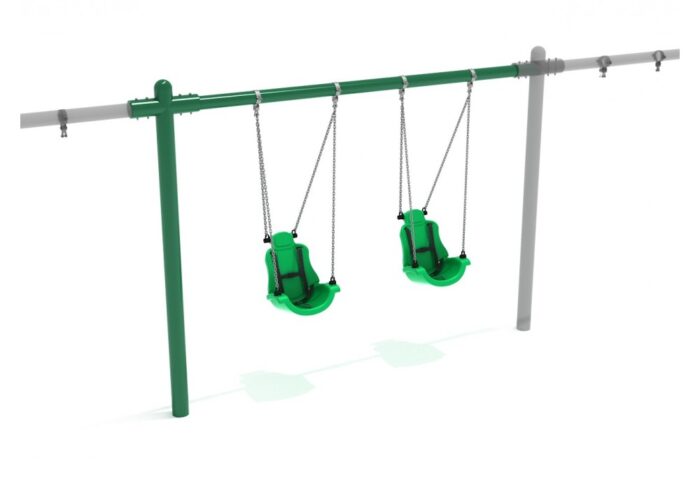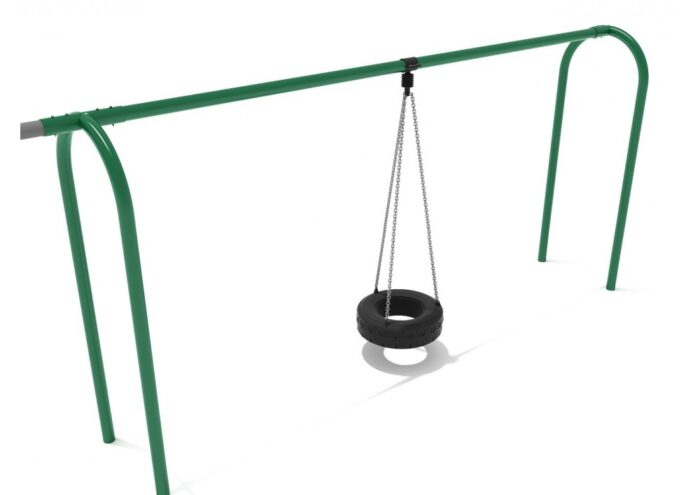Your cart is currently empty!
Swing Sets
- Free Standing Play
- Inclusive Play
- Infant & Toddler
- Swing Sets
Showing 1–16 of 39 results
-
8 feet high Elite Single Post Swing – Add a Bay
$1,094.40 – $1,252.80 -
8 feet high Elite Single Post Swing – 1 Bay
$1,398.60 – $1,557.00 -
8 Feet High Elite Arch Post Swing – Add a Bay
$1,405.80 – $1,564.20 -
8 Feet Single Post Adaptive Swing
$1,698.57 – $2,345.76 -
7 feet high Elite Early Childhood T Swing – 2 Cantilevers
$1,751.40 – $2,031.30 -
8 Feet High Elite Single Post Adaptive Swing – Add a Bay
$1,583.10 -
8 Feet High Elite Arch Post Tire Swing – Add a Bay
$1,822.95 – $2,086.65 -
7/8 feet high Elite Cantilever Swing – 1 Bay 1 Cantilever
$1,863.00 – $2,163.15 -
8 Feet High Elite Arch Post Swing – 1 Bay
$1,875.30 – $2,042.50 -
7/8 feet high Elite Cantilever Swing – 1 Bay 2 Cantilevers
$1,885.50 – $2,323.80 -
8 Feet Arch Post Adaptive Swing
$2,016.09 – $2,663.28 -
8 Feet High Elite Arch Post Adaptive Swing – Add a Bay
$1,869.30 -
8 feet high Elite Arch Post Tire Swing
$2,193.75 – $2,457.45 -
8 feet high Elite Single Post Swing – 2 Bays
$2,493.00 – $2,809.80 -
8 Feet High Elite single Post Swing with Child Adaptive Seats – Add a Bay
$2,358.00 -
8 Feet High Elite Arch Post Tire Swing – Add a Bay (to Arch Post Bay)
$2,398.95
Playground Swing Sets
Playground swing sets, more than just outdoor fixtures, are pivotal in shaping the early experiences of outdoor play for children. They combine the thrill of motion with the benefits of outdoor activity, all within the framework of safety and inclusivity. This exploration into the design, construction, and maintenance of swing sets unveils the intricate balance between fostering joyous childhood memories and adhering to rigorous safety standards. From the selection of durable materials to the incorporation of age-appropriate designs and the latest trends in playground equipment, this article offers a comprehensive look at how swing sets are evolving to meet the needs of a new generation. With a focus on ensuring longevity and maximizing the investment in play equipment, we’ll also navigate through the crucial practices of regular maintenance and safety compliance, essential for preserving the integrity and safety of these beloved structures.
What are playground swing sets?
Playground swing sets are dynamic structures designed to provide children with a sense of flight and freedom through swinging motion. They are a staple of outdoor play areas, offering not just entertainment but also promoting physical development and social interaction among children. Constructed from various materials such as wood, metal, and plastic, these sets come in numerous designs to cater to different age groups and abilities, ensuring inclusivity and safety for all users. The evolution of swing set designs reflects a commitment to enhancing children’s outdoor play experiences while prioritizing their well-being and safety.
Types of Playground Swing Sets
- Standard Swing Sets: These traditional swings feature a simple design with one or more seats suspended by chains or ropes from a metal or wooden frame. They are suitable for a wide range of ages and provide the classic swinging experience.
- Tire Swings: A variation of the standard swing, tire swings use a large rubber tire suspended horizontally or vertically, allowing for a unique swinging or spinning motion. They encourage group play and are often seen as a nostalgic element in playgrounds.
- Bucket Swings: Designed for infants and toddlers, bucket swings have a fully enclosed seat with leg holes, providing additional safety and support for younger children as they experience swinging for the first time.
- Adaptive Swings: These swings are specially designed to accommodate children with disabilities, featuring high-back seats, harnesses, and more secure fastenings to ensure a safe and inclusive swinging experience for all children.
- Bench Swings: Larger than standard swings, bench swings can accommodate multiple children or even adults at once, making them a popular choice for family-friendly playgrounds.
- Standing Swings: For older children seeking more excitement, standing swings allow users to stand on a board or disc while holding onto ropes or handles, challenging their balance and coordination.
Unique Features of Swing Sets
- Integrated Play Options: Some modern swing sets incorporate slides, climbing structures, and interactive panels to offer a multifaceted play experience.
- Sensory Elements: Swings with textured seats, musical components, or visually stimulating designs cater to sensory play, supporting the development of sensory processing skills.
- Eco-Friendly Materials: With a growing focus on sustainability, many swing sets are now made from recycled plastics or sustainably sourced wood, aligning with environmental values.
- Customizable Designs: Modular swing sets allow for customization and expansion, enabling playgrounds to adapt and grow with the community’s needs.
Playground swing sets, through their diverse designs and features, not only provide fun and excitement but also play a crucial role in the physical and social development of children. From the classic joy of a standard swing to the inclusive embrace of adaptive swings, these structures continue to evolve, ensuring that every child can experience the thrill of swinging.
What are current swing set design trends?
The landscape of playground swing sets is witnessing a transformative shift, embracing innovation and sustainability. Current trends include the incorporation of technology to create interactive play experiences, fostering engagement and learning. The move towards natural and organic designs is gaining momentum, with swing sets being crafted to blend seamlessly with the outdoor environment, promoting a connection with nature. Additionally, there’s a growing focus on inclusive play spaces, ensuring that children of all abilities can enjoy and benefit from playground equipment. These trends not only reflect changing societal values but also underscore a commitment to creating diverse, safe, and stimulating play environments for children.
Incorporating technology
The integration of technology into swing set designs marks a significant trend, aiming to enrich the play experience with interactive elements. Examples include:
- Augmented Reality (AR) Play: Swing sets equipped with AR technology allow children to interact with digital elements superimposed on the real world, turning a simple swing ride into an immersive adventure. For instance, the “SkyRide” playground in California uses AR to create an interactive space adventure where children can navigate through galaxies while swinging.
- Interactive Apps: Companion apps that encourage outdoor play are being developed alongside swing sets. These apps might offer challenges, track swing speeds, or provide educational content related to physical activity.
Natural and organic designs
Swing sets are increasingly being designed to harmonize with the natural environment, featuring organic shapes and sustainable materials. Examples include:
- EcoPlay Parks: These playgrounds utilize swing sets made from untreated wood and recycled materials, designed to mimic the shapes and forms found in nature. The “Green Haven” playground in Oregon, for example, features swing sets that blend into the surrounding forest, with structures that resemble tree branches and leaves.
Focus on inclusive play spaces
Inclusivity has become a cornerstone of modern swing set design, ensuring that children of all abilities have access to play. Notable examples include:
- Harmony Park: Located in Minnesota, this playground is renowned for its inclusive design, featuring swing sets with adaptive seats, tactile panels for sensory play, and wheelchair-accessible platforms. The park’s design allows children of all abilities to play side by side, fostering a sense of community and belonging.
What is age-appropriate design?
Age-appropriate design in playground swing sets is crucial for ensuring that play equipment meets the developmental needs and safety requirements of different age groups. This approach categorizes swings and features based on the abilities and interests of specific age ranges, from infants and toddlers who require more support and protection, to school-aged children who seek more challenging and interactive play experiences. Additionally, adaptive swings are designed for children with special needs, ensuring inclusivity and accessibility. By tailoring designs to suit various developmental stages, playgrounds can provide safe, engaging, and beneficial play experiences for all children.
Features for infants and toddlers
For infants and toddlers, swing sets are designed with high backs and safety harnesses to provide the necessary support and security. These features ensure that the youngest users can enjoy swinging in a safe manner. Additionally, the materials and textures are chosen to be gentle and non-harmful, making these swings not only safe but also comfortable for tender skin. Research indicates that early childhood play significantly contributes to physical coordination, social skills, and cognitive development. According to a study by the American Academy of Pediatrics, regular physical play in young children can enhance attention span, motor skills, and social interaction capabilities.
Swings for school-aged children
Swing sets for school-aged children are crafted to offer more freedom and challenge, catering to their growing independence and physical capabilities. These swings might include tire swings or standing swings, which encourage balance and coordination. The design focuses on fostering a sense of adventure while maintaining safety standards suitable for this age group. Innovative designs like the “Sky Surfer” swing allow children to stand or sit while swinging, promoting teamwork and imaginative play. Such designs challenge older children by requiring them to maintain balance and coordinate movements, thereby enhancing their physical agility and social interaction.
Adaptive swings for special needs
Adaptive swings are a testament to inclusive design, ensuring that children with special needs have the opportunity to experience the joy of swinging. These swings may feature high backs, harnesses, and larger seats to accommodate various physical needs. The goal is to create an accessible play environment where all children can participate equally, highlighting the importance of inclusivity in playground design. Communities around the world have seen the positive impact of installing adaptive swings. For instance, the “Harmony Park” project in Texas introduced adaptive swings, resulting in increased playground visits and social interactions among children with and without disabilities. This initiative has been praised for promoting inclusivity and understanding among the community’s youth.
Age-appropriate design is more than just creating safe play spaces; it’s about understanding the developmental stages of children and providing them with opportunities to grow, learn, and interact with their peers in a supportive environment. By incorporating features that cater to various age groups and abilities, playgrounds can become a cornerstone of childhood development, offering diverse and enriching experiences for all children.
Why is design and safety crucial?
The design and safety of playground swing sets are fundamental to prevent injuries and ensure a secure play environment for children. Adhering to international safety standards is paramount, as it guides the construction and layout of swing sets to minimize risks. The design plays a critical role in eliminating hazards, such as sharp edges or entrapment spaces, that could harm children during play. Moreover, thoughtful design contributes to the overall functionality and accessibility of playground equipment, making it suitable for children of various ages and abilities. Ensuring safety through design not only protects children but also fosters a trusting environment where parents feel confident about their children’s well-being during play.
International safety standards
Adherence to international safety standards is a cornerstone of playground design, ensuring that swing sets are constructed with the utmost care for children’s safety. Key standards include:
- ASTM F1487-17: This standard, developed by ASTM International, outlines safety specifications for public playground equipment, focusing on minimizing the risk of falls and entrapment.
- EN 1176: The European standard for playground equipment, which provides detailed guidelines on materials, installation, and inspection to ensure safety across playgrounds in Europe.
- CPSC Publication #325: The U.S. Consumer Product Safety Commission’s guidelines for public playground safety, offering comprehensive recommendations for designing safer playgrounds.
Recent updates to these standards have emphasized the importance of inclusive design, ensuring playgrounds are accessible and enjoyable for children with disabilities.
Design’s role in preventing injuries
The role of design in preventing injuries on playgrounds cannot be overstated. Thoughtful design considerations, such as the inclusion of soft landing surfaces, the spacing between swings, and the elimination of pinch points, are crucial for reducing the likelihood of accidents. Data from the Centers for Disease Control and Prevention (CDC) indicate that emergency department-treated injuries related to playground equipment have decreased significantly, from approximately 200,000 annually in the 1990s to around 155,000 in recent years. This decline can be attributed in part to improved playground design and adherence to safety standards.
Designers also focus on creating age-appropriate features that match the physical capabilities of their intended users, further minimizing the risk of injury. For example, incorporating lower-height swings for younger children and more challenging equipment for older kids can help ensure that playgrounds cater to all ages safely.
Through careful planning and design, playgrounds can be places of joy and exploration, free from unnecessary hazards. By adhering to international safety standards and prioritizing thoughtful design, playgrounds not only become safer but also more engaging and inclusive for all children.
What materials are used in construction?
The durability and safety of playground swing sets largely depend on the materials used in their construction. Pressure-treated wood, known for its resistance to rot and pests, is a popular choice for its natural aesthetic and structural integrity. Galvanized steel offers unmatched durability and strength, making it ideal for swing sets that withstand heavy use and harsh weather conditions. Recycled plastics have emerged as an eco-friendly alternative, providing a low-maintenance option that resists fading and cracking. These materials are selected not only for their longevity but also for their ability to ensure a safe play environment for children.
| Material | Advantages | Disadvantages | Real-World Examples |
| Pressure-treated wood | Natural look integrates with outdoor settings; Resistant to decay, insects, and weathering. | Requires regular maintenance like sealing; Can splinter over time. | Sunnydale Park: Features a large wooden swing set that has been in use for over a decade, showcasing the material’s durability and aesthetic appeal. |
| Galvanized steel | Extremely durable and strong; Resistant to rust and corrosion; Low maintenance. | Higher initial cost; Can conduct heat, making it hot to touch in warm weather. | Riverfront Play Area: Utilizes galvanized steel swings that withstand heavy use and exposure to elements, demonstrating the material’s resilience and safety. |
| Recycled plastics | Eco-friendly; Low maintenance; Does not splinter, fade, or crack. | Less sturdy than wood or steel in extreme weather conditions; Can be expensive. | EcoPlay Park: Known for its colorful recycled plastic swing sets, this park exemplifies sustainability and safety, attracting families who prioritize environmental consciousness. |
How does construction affect durability?
The construction methods and quality of materials used in building playground swing sets significantly impact their durability and lifespan. Joint construction is a critical factor, as well-designed joints can enhance the structural integrity of the swing set, ensuring it can withstand frequent use and harsh weather conditions. Similarly, the choice of material plays a pivotal role in determining the swing set’s resistance to wear, decay, and corrosion. Proper construction techniques combined with high-quality materials contribute to the creation of durable, long-lasting playground equipment that requires minimal maintenance while providing a safe play environment for children for years to come.
Importance of joint construction
The joint construction in playground swing sets is vital for ensuring structural stability and safety. Well-crafted joints not only support the weight and movement of users but also contribute to the overall durability of the equipment. Poorly constructed joints can lead to premature wear and potential safety hazards. Therefore, precise engineering and quality craftsmanship in joint construction are essential for extending the life of swing sets and maintaining a secure play environment.
| Joint Type | Description | Durability Impact | Examples |
| Bolted Joints | Metal bolts are used to secure parts together. | High durability if regularly inspected and tightened; susceptible to loosening over time. | Adventure Park Swing Sets: Utilizes bolted joints for easy maintenance and strong construction. |
| Welded Joints | Parts are welded together to form a permanent bond. | Very high durability; less prone to loosening but more difficult to repair. | Steel City Playground: Features welded steel swing sets known for their resilience and longevity. |
| Interlocking Joints | Parts fit together like puzzle pieces, often secured with adhesive or bolts. | Good durability; provides some flexibility in construction, but requires precise manufacturing. | EcoPlay Area: Uses interlocking wooden joints for a natural look and easy replacement of parts. |
Impact of material choice on lifespan
The choice of material directly influences the longevity and maintenance needs of playground swing sets. Materials like pressure-treated wood, galvanized steel, and recycled plastics offer different benefits in terms of durability, resistance to environmental factors, and sustainability. Selecting the appropriate material based on the playground’s specific needs and environment can significantly extend the equipment’s useful life, ensuring it remains safe and enjoyable for children for many years.
| Material | Lifespan Estimate | Maintenance Requirements | Environmental Resistance | Case Study |
| Pressure-treated wood | 10-15 years | High (annual sealing) | Good (resistant to rot and pests) | Greenwood Park: After 12 years, the wooden swing sets remain in good condition with regular maintenance. |
| Galvanized steel | 20-30 years | Low (occasional painting) | Excellent (resistant to rust and corrosion) | Riverside Playground: Steel swings have withstood 25 years of use with minimal rust and wear. |
| Recycled plastics | 15-20 years | Very Low (simple cleaning) | Good (resistant to fading and cracking) | EcoWorld Play Area: Plastic swing sets show no signs of fading or wear after 18 years, requiring only basic cleaning. |
How to maintain swing sets?
Maintaining playground swing sets is essential for ensuring their longevity and safety. Regular safety checks, seasonal maintenance tasks, and promptly handling wear and tear are crucial practices. By adhering to a consistent maintenance routine, playground operators can extend the life of swing sets and provide a secure environment for children to play.
Maintenance Checklist
| Task | Frequency | Details |
| Safety Inspections | Monthly | Check for loose bolts, worn parts, structural damage. Inspect for sharp edges and rust. |
| Hardware Tightening | Quarterly | Tighten all bolts and fasteners to ensure stability. |
| Cleaning | Monthly | Clean all surfaces to remove dirt, debris, and potential contaminants. |
| Painting/Sealing | Annually | Repaint metal parts and seal wooden parts to protect against weather and wear. |
| Rust Removal | As needed | Use a wire brush or sandpaper to remove rust, followed by application of a rust inhibitor. |
| Part Replacement | As needed | Replace worn or broken parts immediately to maintain safety and functionality. |
| Lubrication of Moving Parts | Bi-annually | Apply appropriate lubricant to swing hinges and other moving parts to ensure smooth operation. |
| Ground Cover Inspection | Quarterly | Check and replenish ground cover material to maintain appropriate fall protection. |
| Weather Damage Checks | After severe weather events | Inspect for damage caused by storms, snow, or extreme temperatures and take corrective action. |
Seasonal Maintenance Tasks
| Season | Task | Details |
| Spring | General Inspection & Cleaning | Address winter wear. Prepare for increased spring use. |
| Summer | Sun Damage Inspection | Check for fading, warping, or heat damage. Apply UV protectant where necessary. |
| Fall | Leaf and Debris Removal | Clear fallen leaves and debris that may hide hazards or trap moisture. |
| Winter | Snow and Ice Removal | Keep swing sets clear of snow and ice to prevent rust and corrosion. |
This comprehensive maintenance schedule ensures that playground swing sets remain in optimal condition, providing a safe and enjoyable environment for children throughout the year. Regular upkeep not only extends the life of the equipment but also maximizes the investment in play facilities, contributing to the community’s well-being and enjoyment.
Benefits of proper maintenance?
Proper maintenance of playground swing sets yields significant benefits, foremost among them being the extension of the equipment’s life. Through regular upkeep, playgrounds can avoid the costly replacement of structures and ensure their swing sets remain functional and appealing for years. Additionally, consistent maintenance ensures ongoing safety compliance, protecting children from potential hazards and reducing the risk of accidents. This proactive approach not only safeguards the well-being of users but also enhances the playground’s reputation as a secure and enjoyable environment. Furthermore, by investing in regular maintenance, playground operators maximize their investment in play equipment, ensuring it continues to deliver value and enjoyment to the community.
Extending swing set life
Extending the life of swing sets is a primary benefit of diligent maintenance. Regular inspections and timely repairs prevent minor damages from escalating, thereby avoiding premature equipment failure. This not only ensures that the swing set remains a staple of childhood joy but also represents a cost-effective strategy, reducing the need for frequent replacements.
Ensuring ongoing safety compliance
Ensuring ongoing safety compliance through maintenance is vital for creating a secure play environment. Adherence to safety standards minimizes the risk of accidents and injuries, protecting children as they play. Routine checks and updates to the equipment also keep playgrounds aligned with the latest safety guidelines, instilling confidence among parents and caregivers.
Maximizing investment in play equipment
Maximizing the investment in play equipment is achieved by maintaining its condition and functionality over time. Proper care extends the usability of swing sets, ensuring they continue to provide value and entertainment to the community. This approach not only enhances the appeal of public play spaces but also supports the long-term financial sustainability of playground projects.

